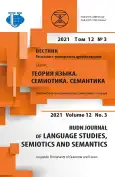Numeral Systems in Various Fula Lects
- 作者: Kosogorova M.A.1
-
隶属关系:
- IAAS Lomonosov Moscow State University Institute of Linguistics RAS
- 期: 卷 12, 编号 3 (2021): Linguistic dominants of grammar and lexics
- 页面: 714-734
- 栏目: FUNCTIONAL SEMANTICS AND LINGUISTIC SEMIOTICS
- URL: https://journal-vniispk.ru/2313-2299/article/view/323361
- DOI: https://doi.org/10.22363/2313-2299-2021-12-3-714-734
- ID: 323361
如何引用文章
全文:
详细
The paper presents the analysis of Fula numeral system. Fula is an Atlantic language, dispersed throughout a vast territory in Sub-Saharan Africa. It has over 20 differently-sized lects subdivided into three zones - Western, Central and Eastern. The research included collecting the language data on six major lects, two from each zone. Then this data was analyzed from the point of view of internal and external syntax of ordinal, cardinal, distributive and fraction numerals. The comparative analysis of Fula numeral system on inter-lect scale has never been reflected in earlier Fula studies. Apart from a unique collection of numeral data from all language zones of Fula, the paper presents comparative analysis of such data, including, but not limited to, phonetic and contact-induced variabilities. The sources of structural and lexical loans in the system are listed wherever possible, because the disperse nature of Fula lects means that the contact languages and the ensuing changes can be different for each lect. Special attention is paid to the numeral bases, which can be somatic, commercial of a combination of the two. The Fula numeral system has never been analyzed from this point of view, and the contact changes to it are of great linguistic interest. Also cardinal numerals in Fula can change their form depending on the personality parameter of head noun. This system is unique for Fula and, more specifically, to its numeral system, and is properly described for the first time. Some parts of the Fula numeral system, like distributive and fraction numerals for some lects, have been found underrepresented and poorly described, which leaves room for further research, both field one and typological.
作者简介
Maria Kosogorova
IAAS Lomonosov Moscow State University Institute of Linguistics RAS
编辑信件的主要联系方式.
Email: maria.kosogorova@gmail.com
ORCID iD: 0000-0001-7145-4710
Ph.D., leading research fellow of the Department of African Studies IAAS Moscow State University; research fellow of the African linguistics department, Institute of Linguistics RAS
12/1 Bolshoi Kislovski Per., Moscow, Russian Federation, 125009参考
- Eberhard, D.M., Gary F.S, & Charles D.F. (eds.). (2020). Ethnologue: Languages of the World. Dallas, Texas: SIL International. URL: http://www.ethnologue.com (accessed: 01.03.2021).
- Arnott, D.W. (1970). The Nominal and Verbal Systems of Fula. Oxford: Clarendon Press.
- de Wolf, P.P. (1995). English-Fula dictionary: a multidialectal approach (Fulfulde, Pulaar, Fulani). Berlin: Dietrich Reimer Verlag.
- Koval, A.I., Zoubko, G.V. (1986). Fula language. Moscow: Nauka. (In Russ.).
- Diallo, A. (2000) Grammaire Descriptive du pular du Fuuta Jaloo (Guinée). Schriften zur Afrikanistik, 3. Frankfurt am Main: Peter Lang.
- Niang, M.O. (1997). Pulaar: Pulaar-English, English-Pulaar standard dictionary. New York: Hippocrene Books.
- Fagerberg-Diallo, S.M. (1984). A practical guide and reference grammar to the Fulfulde of Maasina. Jos: Joint Christian Min. in West Africa.
- Klingenheben, A. von. (1963). Die Sprache der Ful. Glückstadt: J. J. Augustin.
- Noye, D. (1974). Cours de foulfouldé, dialecte peul du Diamaré, Nord-Cameroun: grammaire et exercises, textes, lexiques peul-français et français-peul. Paris—Maroua: Librairie Orientaliste.
- Olderogge, D.A. Counting systems in languages of Tropical and South Africa. In: African ethnographic anthology XIII. Leningrad. pp. 1—33. (In Russ.).
- Comrie, B. (1997). Typology of numeral systems. Numeral types and changes worldwide. URL: https://mpi-lingweb.shh.mpg.de/numeral/TypNumCuhk_11ho.pdf (accessed: 01.03.2021).
- Greenberg, J.H. (1990). Generalizations about Numeral Systems. In: Keith Denning & Suzanne Kemmer (eds.), On language: Selected writings of Joseph H. Greenberg. Stanford: Stanford University Press. pp. 271—309.
- Blažek, V. (1999). Patterns of creating numerals. In: Numerals: Comparative-etymological Analyses of Numeral Systems and Their Implications: (Saharan, Nubian, Egyptian, Berber, Kartvelian, Uralic, Altaic and Indo-European languages). Vyd. 1. V Brně: Masarykova univerzita. pp. 325—337.
- Pozdniakov, K. (2018). The numeral system of Proto-Niger-Congo: A step-by-step reconstruction (Niger-Congo Comparative Studies 2). Berlin: Language Science Press.
- De Lancey, S. (1992). Klamath and Sahaptian numerals. International Journal of American Linguistics, 58, 235—239.
- Lazareva O.V., Lee S. (2012) Quantitativity in Russian and Korean languages. RUDN Journal of Langauge Studies, Semiotics and Semantics, 3, 80—86. (In Russ.).
- Shluinsky, A.B. (2017). Susu language. In: World Languages. Mande Langages. Saint Petersburg, Nestor-Istorija. pp. 221—247. (In Russ.).
- Kosogorova, M.A. (2020). Morphological and syntactic properties of a lexeme ‘one’ in Fula. In: Proceedings of Lomonosov memorial conference, Oriental and African studies. Moscow, 2020. pp. 13—15 (In Russ.).
- Perekhvalskaya, E. & Vydrin, V. (2019). Numeral systems in Mande languages. Mandenkan, 61 URL: http://journals.openedition.org/mandenkan/1951; DOI: https://doi.org/10.4000/ mandenkan.1951 (accessed: 01.03.2021).
- Hammarström, H., Forkel, R., Haspelmath, M. & Bank, S. (2020). Glottolog 4.2.1. Jena: Max Planck Institute for the Science of Human History URL: https://doi.org/10.5281/zenodo.3754591 (accessed: 01.03.2021).
- Arnott, D.W. (1974). Some aspects of the study of Fula dialects. Bulletin of the School of Oriental and African Studies, 37(1), 8—18.
- Labatut, R. (1981). Réflexions sur la numération peule. In: Itinérances en pays peul et ailleurs; mélanges réunis à la mémoire de P.F. Lacroix, Mémoires de la Société des africanistes, Paris. Vol. 1. pp. 91—102. (In Franch).
- Erlmann, V. (1983). Notes on Musical Instruments among the Fulani of Diamare (North Cameroon). In: African Music, 6(3), 16—41.
补充文件









